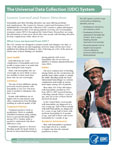Universal Data Collection (UDC) System
 One of the major challenges facing scientists who work on rare disorders, such as hemophilia, is lack of uniform health data. To address this issue and to advance health research, CDC created a national public health surveillance project called the Universal Data Collection (UDC) system. UDC is carried out with the help of federally funded hemophilia treatment centers (HTCs) in the United States and its territories.
One of the major challenges facing scientists who work on rare disorders, such as hemophilia, is lack of uniform health data. To address this issue and to advance health research, CDC created a national public health surveillance project called the Universal Data Collection (UDC) system. UDC is carried out with the help of federally funded hemophilia treatment centers (HTCs) in the United States and its territories.
Since the system began in 1998, about 24,000 people with bleeding disorders have contributed their health data by participating in the UDC program. More than 80% of all people with hemophilia who receive care at HTCs participate.
Lessons Learned and Future Directions
View and print English Version»
View and print Spanish Version»
UDC Data Reports
UDC data and reports are available to HTC staff. Staff at each HTC can download electronic files containing UDC data collected from participants at their HTC. In addition, continuously updated national and regional reports are available to the public on CDC’s website.
Important Findings
Several articles about studies that used UDC data have been published. A few of the findings so far are:
- Youth with hemophilia are just as likely as youth among the general population to be overweight.1
- Youth with hemophilia who are overweight are more likely to have decreased joint mobility than those who are not overweight.1
- Joint infections are a rare complication of hemophilia, but they are more common among people with hemophilia than among those without the condition. Infections happen mainly in problem joints that bleed frequently or have undergone joint surgery.2
- No new infections of hepatitis A, hepatitis B, hepatitis C, or HIV have been linked to blood products used to treat bleeding disorders.3
- Among deaths of people with bleeding disorders reported to CDC during the period 1997–2007, the most common causes were related to HIV infection (19%) and liver disease (22%) probably related to hepatitis C infection. Both of these infections could be transmitted by clotting factor products before 1986. Hemophilia-related (bleeding) causes of death were less common (12%).4
- The most common sites of bleeding among babies with hemophilia are the circumcision site and the head. Bleeding inside the head (intracranial hemorrhage) is a very serious complication and can result in long-term effects such as seizures and learning disabilities.5
- The rate of new inhibitors (antibodies to clotting factor products) among previously treated patients with hemophilia is very low. However, more study is needed to determine why they occur because an inhibitor makes treating hemophilia more complicated and expensive.6
Learn more about the UDC system
References
- Soucie JM, Cianfrini C, Janco RL, et al. Joint range of motion limitations among young males with hemophilia: Prevalence and risk factors. Blood 2004; 103:2467-73.
- Ashrani AA, Key NS, Soucie JM,Duffy N, Forsyth A, Geraghty S and the Universal Data Collection Project Investigators. Septic arthritis in males with haemophilia. Haemophilia 2008; 14:494-503.
- CDC. Blood Safety Monitoring Among Persons with Bleeding Disorders. MMWR January 3,2003;51(51-52);1152-54.
- Poster Presentation. Larsen NM et al: Mortality Among Patients Treated at Federally Funded Hemophilia Treatment Centers (HTCs). National Hemophilia Foundation Annual Meeting October 2007.
- Kulkarni R, Soucie JM, Lusher J, et al. Sites of initial bleeding episodes, mode of delivery and age of diagnosis in babies with haemophilia diagnosed before the age of 2 years: a report from the Centers for Disease Control and Prevention’s (CDC) Universal Data Collection (UDC) project. Haemophilia e-pub July 22, 2009.
- Kempton CL, Soucie JM, Abshire TC. Incidence of inhibitors in a cohort of 838 males with hemophilia A previously treated with factor VIII concentrates. J Thromb Haemostasis 2006; 4:2576-2581.
Contact Us:
- Centers for Disease Control and Prevention
National Center on Birth Defects and Developmental Disabilities
Division of Blood Disorders
1600 Clifton Road
MS E-87
Atlanta, GA 30333 - 800-CDC-INFO
(800-232-4636)
TTY: (888) 232-6348
New Hours of Operation
8am-8pm ET/Monday-Friday
Closed Holidays - cdcinfo@cdc.gov



